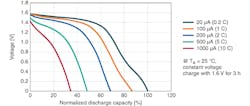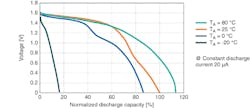Considerations for IoT Designs with Rechargeable Solid-State Batteries
Imagine buying a smart watch that’s as small as the watch you owned five years ago with the same battery life. Or designing a hearing aid that was small enough to be hidden and only needed to be recharged once a year. It seems almost impossible with today’s technology, but advances in power technology are paving the way for this to become a reality.
Power—and having enough of it for long periods of time—is the biggest obstacle facing Internet of Things (IoT) devices. These devices, from wearables to consumer gadgets to industrial applications, all require compact, reliable, and extremely safe battery-powered sources.
Power Requirements
The most significant consideration when designing devices for the IoT must be power. IoT devices already require millions of distinct power supplies that are customized to take advantage of ultra-low-power components, including semiconductors, sensors, and displays. The batteries that power these devices must also be tailored based on the unique needs of the application.
Many of these devices require a long lifespan, needing to last for many years without having to recharge. In such cases, energy-harvesting technologies can reduce their dependence on external power supplies, allowing the device to charge itself based on motion or other variables.
Engineers must consider the differing capacities, size dimensions, rechargeability, cost, service life, and safety of each battery option. They must also ensure that battery technology is easy to assemble and doesn’t disrupt the manufacturing process. Few battery technologies meet all of these technological requirements.
Ceramic Batteries
Ceramic solid-state battery technology may be one consideration for engineers to address these needs. Unlike other battery technology, ceramic batteries are a solid-state rechargeable battery with no liquid electrolyte through which the lithium ions move during use—whether charging or discharging (Fig. 1). This makes the devices intrinsically safe.
Ceramic solid-state batteries have all of the benefits associated with multilayer ceramic components. Most ceramic solid-state batteries are based on multilayer technology, which is similar to multilayer ceramic capacitors (MLCCs). The use of solid ceramic electrolyte removes the risk of leakage, fire, or explosion in both the manufacturing process and in the end application.
Benefits of SMD Solid-State Battery Technology
In addition, by combining advanced copper electrode technology with multilayer technology, some ceramic solid-state batteries (SSBs) can be surface-mounted and handled in the same way as chip-type passive components. This helps reduce the production cost of electronic devices.
Not only is this type of technology exceptionally safe, but solid-state batteries have the potential for tremendously higher energy density than lithium-ion batteries or other battery technology. Solid-state battery technology employs electrodes and electrolytes in a solid state rather than in a liquid, polymer, or hybrid plastic polymer state, which is the main characteristic of lithium-based and other battery technology.
The materials used as solid electrolytes in solid-state batteries include solid polymers and ceramics, such as oxides, phosphates, and sulfides. Due to the intrinsic safeness, solid-state batteries are ideal for use in wearable devices and other portable electronics, including radio-frequency identification (RFID).
Many engineers only consider the slightly higher cost for a much higher energy density and increased safety as a wise tradeoff, as if that was the only consideration. However, there’s more to be considered with cost.
For example, surface-mounting (SMD) SSBs reduce the number of holes that need to be drilled into the circuit board. This requires less manufacturing processes and fewer packaging materials to attach. Such processes also allow engineers to place the battery on either side of the board. Each of these benefits provides more efficient circuit-board placement and reduces both the cost and size of the device.
TDK’s CeraCharge was the first rechargeable battery to be designed as an SMT-compatible component. CeraCharge comes in an EIA 1812 package (4.5 × 3.2 × 1.1 mm), and has a capacity of 100 µAh at a rated voltage of 1.5 V. The solid-state battery allows for easy placement as well as the use of conventional reflow soldering processes. Using reflow soldering processes helps reduce production costs of the devices.
Discharge and Temperature Considerations
Figure 2 shows the typical discharge characteristics of a ceramic solid-state battery. The nominal discharge current is 20 µA, but one solid-state battery is also able to support a continuous discharge of 1 mA (10 C).
The number of charge/discharge cycles that a solid-state battery is required to perform may range from several dozen up to 1,000 without any significant losses (Fig. 3).
Compared to conventional batteries, rechargeable or otherwise, ceramic solid-state batteries can offer a very wide temperature range, making it appropriate for applications outdoor as well as indoor. Figure 4 illustrates typical temperature characteristics.
Wide Range of Applications
Most solid-state batteries can be connected in a parallel series, thereby increasing the capacity and voltage of the application. This allows the technology to be used in an extremely wide range of possible applications, including battery-backup for real-time clocks (RTCs), storage for energy harvesting, sub-battery in wearables, and energy storage for Bluetooth beacon transmission.
In most cases primary cells—also called coin cells—may be used as the battery for RTCs. However, this conventional solution has several disadvantages; for example, users must change the battery. Because a VSB (supply voltage to battery) exists in an RTC, replacing the primary cell with a solid-state ceramic rechargeable battery addresses this disadvantage (Fig. 5). The RTC generally needs power from the backup battery for less than one hour at a time, and one solid-state ceramic rechargeable battery can back up the RTC function for one to four weeks without any recharging.
The requirement of the IoT presents itself in the need to connect all kinds of appliances and devices to the internet. One solution that’s being quickly adopted is solar-powered Bluetooth Low Energy (BLE) beacon technology. This technology is emerging as the connectivity solution of choice because of its miniature space requirements and low power consumption.
In such a circuit, the solar cell first charges a MLCC or electric double-layer capacitor (EDLC). This capacitor, in turn, provides the principal power for the BLE module. A solid-state battery stores energy in order to charge the capacitor, when the solar cell isn’t active.
The solid-state battery is then charged with any surplus energy after the capacitor is fully charged. It also discharges stored energy to the capacitor when needed. This enables the solar-powered beacon to operate continuously. The main consideration in this example is how many parallel solid-state batteries are needed in the circuit.
When used in combination with a capacitor, solid-state batteries can smooth current and voltage levels during momentary periods of high demand.
Conclusion
By understanding these design considerations, engineers can best design efficient IoT devices. Ceramic solid-state technology has the potential to reduce the number of battery changes by end users, helping them to be more satisfied with the application. While the batteries must be tailored to the unique needs of the application, ceramic solid-state battery technology addresses the most significant obstacle facing IoT devices, ensuring they have power.
Matt Reynolds is a director of product marketing for piezo-electric and circuit protection devices at TDK Electronics Inc.





